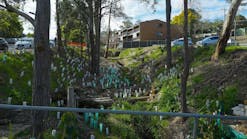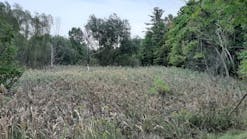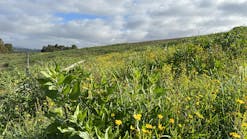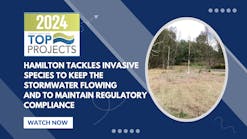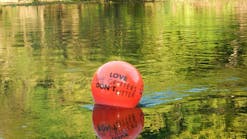Green Solutions: Planting Trees for Healthy Watersheds
July 1, 2001
It’s exciting to think about doing something as promising as planting trees. It’s both sobering and wonderful to know the results will be around longer than our own children. But people who have completed successful urban reforestation projects caution that it’s not something we can just stroll into. It takes eight months to a year to plan and carry out a project. A planting project’s many phases need support from a lot of people, and the newly planted trees need TLC for a number of years. Planting a new forest is actually a multiyear commitment for a dedicated team.The team should include people who can help with marketing, leading groups, reaching out to the community, and managing budgets, schedules, and logistics. It should also include some technical folks who can make decisions about soils, plants, erosion, site drainage, zoning, wetlands, wildlife, and other natural-resource considerations.Assess Potential Planting Sites
Many community groups have found that local, state, and federal government agencies are eager to lend expertise and grant funding to local reforestation efforts. Park departments, watershed groups, and surface-water managers often have a few planting sites on their high-priority list and are looking for partners to help.If no ready-made sites are available, the team can come up with a list of candidate sites and learn what biological, physical, and social opportunities and constraints are associated with each. To begin, research the history of past site uses to learn whether heavy metals, pesticides, herbicides, deicing or petroleum compounds, or other contaminants might be present that would inhibit plant growth. Study aerial photographs taken of the site over a long period of time. If there is evidence of hazardous materials or spills, illegal habitation, or dumping or spraying of unknown chemicals, the team should consider another site.The free county soil survey is a storehouse of useful information about local soils, their drainage, hazard of erosion, water-holding capability, and native vegetation they can support. To get a free copy of the survey, call the county office of the Soil and Water Conservation District or visit the Web site of the National Association of Conservation Districts at www.nacdnet.org/. A soil scientist can determine whether the soil can support trees in its present condition. If the team does not have a soils expert, it can buy a soil test on-line at www.gemplers.com or www.forestry-suppliers.com.
Probe or dig to determine whether there are any natural or artificial impermeable subsurface soils that will affect drainage. Then dig a hole 2 ft. deep and fill it with water. If the water drains more slowly than 1 in. per hour, the site might not be suitable for many plants.A wetlands specialist should assess the site to determine whether it is a wetland. There are several clues that the site is a wetland. It might be wet or soggy for several weeks during the growing season most years. Plants that tolerate wet conditions might be present. Soils might be dark near the surface and could contain small mottles of other colors. The soils survey might mention “hydric” soil inclusions, extremely slow drainage, or seasonal flooding.For mapped wetlands of the area, check with the wetlands planner for city, county, or regional government. To locate a wetlands specialist, contact the local watershed council or ask the procurement office of local government for a copy of its roster of qualified wetlands biologists. The local chapter of the Society of Wetlands Scientists at www.sws.org can also help. Work in wetlands and streams requires an application for a joint permit from the state and the US Army Corps of Engineers (www.wetlands.com/regs/tlpge04b.htm). Turnaround time for review and approval may be up to 120 days.If the site is near a stream, it is a good idea to become informed about local stream flow and flooding. If it is periodically flooded, the team will need to know the risk of losing an entire planting. Poke around to learn if stormwater flows onto the site seasonally from roads, parking lots, or nearby developments. Longtime local residents are valuable sources of information about local flooding, as is the local history center. For more information about stream flow, talk to a hydrologist in a local agency office and visit the US Geological Survey’s site at http://water.usgs.gov/. For information about federally mapped floodplains, visit the Federal Emergency Management Agency’s Map Service Center at http://msc.fema.gov/MSC/. Identify LimitationsCheck with the municipal forestry department for restrictions on planting trees or certain tree species near structures, overhead utilities, rights of way, and sidewalks. Call the utility companies to learn the locations of underground services and restrictions to planting along utility corridors. The team should also talk with nearby “people attractors,” such as markets and schools, to determine whether the site is a neighborhood “walkthrough” or a de facto parking area. Then determine whether the site can be protected from litter, vandalism, and compaction by vehicles. Steep or unstable slopes are not safe for volunteer planting crews and will limit how equipment and materials can be staged on the site. Traffic and available parking will affect whether volunteers can safely walk to and from the site to plant and maintain it. On planting day, portable toilets will need to be rented if crews will be on the site all day and restroom facilities are not available.Plan Site Prep Activities
Plant debris on the forest floor supports biota and processes that protect the soil with an absorbent, nutrient-rich mulch.Getting rid of invasive, non-native vegetation tops the list of things that need to be done before planting a site. Non-native plants and other “weeds” can rob native plants of the nutrients, moisture, light, and space they need to survive. When this occurs, local wildlife are deprived of important food and habitat elements that otherwise might be present in the native plant community. For information on controlling specific non-native species, visit The Nature Conservancy’s Invasive Species site at http://tncweeds.ucdavis.edu/. If construction rubble, debris, or other items will need to be removed from the site, it can be worthwhile to ask the solid waste department for help with dumping fees. If mechanized equipment will be used for site preparation and maintenance activities, find out the lightest model that can get the job done. Because approximately 50% of soils’ volume consists of air and water, heavy machinery can compact soils, rendering them less hospitable to plants and making them susceptible to non-native, invasive species. For best results, restrict the areas in which machinery will be operated, and only bring machinery on-site when soils are dry. Make certain there is a nearby source of water and that it will be available for the first several years after planting. Perhaps neighbors will be willing to run their hoses to the project. If it is a large or remote site, the team will want to find a partner, such as a city utility or parks department, that can assist with watering. Although it can be tempting to pump water from a nearby stream, it is important to check if state law allows this without a water right.Choose and Order Plants
Aspect, or the direction a slope faces, influences how quickly the soil warms in spring and how early it warms in the day. These affect site moisture and soil texture, which in turn influence the plants that will thrive there. Look at nearby sites with similar aspect and exposure and note the native plant assemblage thriving there. Make a few calls to learn whether these plants are readily available in the local native plant market.Many planting projects in urban settings need to meet multiple goals. These might include safety and screening, mitigation for a project elsewhere, aesthetics, stormwater treatment, height restrictions, connection with an adjacent wildlife habitat, and ability to withstand site stresses such as buffeting by traffic. Find a landscape designer or a landscape architect with expertise in native plants who can help select native plants that fulfill these other requirements.Check on the availability of species and numbers of plants well in advance of the planting date. If there are unusual species or if a large number of plants is required, the nursery or grower might need six months to a year or more of lead time and might want to enter into a contract for growing the plants. Make certain the order is in by July for fall planting and by January for spring planting. If species substitutions need to be made, project managers will need time to redesign the planting plan. Plants from local seed sources are adapted to local elevations, exposures, and rainfall amounts. When ordering plants, it’s a good idea to specify a local seed zone for the plants being considered for purchase.The team will want to know whether it will be receiving bare root or containerized plants, because each requires different tools, planting methods, and timing. Bare root plants are grown in the ground. They are dug out in winter when they are dormant and transplanted before spring, while conditions are still cool. They are less expensive than containerized plants. While bare root stock is the easiest to handle, its success when planted by untrained community groups is limited. Bare root stock should be planted in January or February.Plants grown in containers are generally available year-round but transplant best when conditions are still cool and the ground is moist. When ordering bare root plants, specify size. Plants should be no smaller than 12 in. and no larger than 40 in. (not including the roots). If planting quantities are few or if planting will occur early in the fall or late in the spring, container stock should be used.For the most part, planting projects use one- to three-year-old seedlings grown in narrow, cylindrical plastic containers. When the containerized plants arrive, a botanist should inspect them to make certain they are the right species and in good condition. The planting medium should be moist, and the plants should be kept cool and not be exposed to direct sunlight or wind so that they do not lose moisture. Bare root stock will arrive packed tightly in boxes or wrapped in bundles. The seedlings should be inspected to make certain they are cool, moist, and pliable and there is no mold developing on them. Leaves or needles should be fresh, and if the stem is gently scratched, there will be pale green just under the bark. Roots should be vigorous, with many small fibers. If the stock cannot be planted for a few days, keep it in a walk-in cooler between 31º and 40ºF. Neighborhood grocery stores often are willing to hold plants in their coolers. Be sure to allow air circulation between the boxes or bundles. It is important to keep the fibrous roots protected in moist mulch while the plants are waiting to be put in the ground.Finalize the Planting PlanThe soils of some sites might need to be tilled before planting to ensure adequate circulation of air, water, and nutrients in the root zone. If soil is compacted and the site is small, site conditions can be improved by cultivating and mulching for one year prior to planting. A thorny question is whether or not amendments (such as composted wood debris) should be added to the soil in the planting hole. Many experts don’t think they should because their presence discourages plants from sending roots beyond the planting hole where conditions might be less hospitable. Over time, the root system might not expand sufficiently to support the tree. Also, water does not flow well across abrupt changes in soil conditions, such as at the boundary of organic matter in a planting hole and a denser native soil just beyond. For these reasons, and to encourage plants to adapt to native soils, amendments are not recommended for planting bare root seedlings.Some experts think that amendments can be helpful to help jump-start bare root street trees, but having a large enough planting hole might be even more important. To avoid the problems discussed above, the backfill for the hole should contain a large percentage of the original mineral soil. Many pros use mulches and composts only as top dressings to keep down weeds, conserve soil moisture, and preserve the structure of the soil and its infiltration capacity.If amendments will be used, determine type, quantity, and cost. Establish what equipment is needed to transport, mix, and apply the amendments.The trees and shrubs should be installed when they have entered dormancy in late fall or in early spring before they have broken dormancy. On the ideal planting day, the weather will still be cool and the soil will be moist but not so wet that it compacts or gets gooey when worked. The best months for planting are usually December, January, and February, but this can vary depending on fluctuations in the weather in any given year. Planting-Day Preparation Tasks
If the plants are large, determine when and how the planting holes will be dug. Sometimes when groups are planting a very large area or large trees, they want to use an auger to dig the holes in order to save volunteer time and labor. Extreme care should be taken if an auger is used because machinery used to transport it around the site can compact site soils. Holes prepared ahead of time can become pitfall traps for small animals. In any case, an augured hole will need to be hand-finished before planting. The sides and bottom must be scored and loosened so that the plant does not become root bound in the hole. The hole also needs to be shaped according to the space needed by the roots.Removing unwanted fill, rubble, and vegetation often results in bare earth and soil stockpiles and sometimes requires earthen access roads for heavy equipment. The team will need to determine the necessary erosion control practices and materials, their costs, and the people power needed to install, inspect, and maintain them. Protect Young Plants
Young, tender plants tend to be high in carbohydrates and are attractive to critters that like to eat them. To protect them from browsing by deer for the first several years after they are planted, use a plastic mesh sleeve that can be stretched over the entire plant. The sleeve is held erect by a 3- to 4-ft. lath or bamboo stake pounded into the ground. Plastic mesh sleeves should not be used where there is a possibility the site will be inundated during high water.If beavers or nutria are present, protect young plants with welded-wire cages 3 ft. high fastened to a metal stake driven into the ground on the upstream side of the plant. The bottom edge of the cage is sunk into a circular trench at least 1 ft. away from the base of the plant. Experts suggest overplanting when beavers are present, because eventually these critters will harvest many woody species. Specially waxed cardboard protectors can help safeguard small trees and shrubs from rodents. Wrapping plant stems with aluminum foil can also deter nibblers.
More often than not, exotic plants move in and overwhelm the new plants. This can happen even in relatively pristine planting areas. Weeds can be introduced in the mulch, yard debris, or straw used for moisture retention or erosion control. Use only seed-free straw and guaranteed weed-free mulches. Exotic plants can still find their way into native plantings by means of animal feces, wind, rhizomes, and other ways. For weed control, place a 3- to 5-in.-thick layer of wood chips, ground bark, leaf mold, compost, or pine needles in a 2-ft. radius around the stem of the plant. If the mulch touches the stem, it could promote rot by retaining moisture. Some people prefer to install about a square yard of black landscaping cloth around each plant. The cloth allows moisture to penetrate but keeps light out, thus inhibiting the growth of competing vegetation. The plant sticks out a slit in the middle of the cloth, and the edges are pulled taut and fixed with long metal staples. During maintenance visits, the cloths are tightened and the staples refastened where they need it, and competing vegetation is removed.The sun can scald some plants when they are young and tender. Waxed cardboard sun shades can be staked so that they cast a shadow on the seedlings to protect them from the sun during the hottest time of day.Connect With the Community
River’s-edge forests help dissipate flood energies, controlling riverbank erosion and providing a place for floodwater to spread out and drop forest-nourishing sediments.It is a huge project in itself to find and keep volunteers who are willing to roll up their sleeves to get a multiphased task done. Community outreach to develop a volunteer cadre begins at the project planning phase and continues for many years after the plants are in the ground. During this entire time, regular communication with all parties involved is an essential part of project success.The team’s communications people will plan ways to publicize the project, get people involved, secure in-kind donations of materials and equipment, coordinate and train work parties, and follow up with appreciation and awards. They will strategize about ways to ask for people’s time and labor by piggybacking on events held by other groups, talking to friends, putting blurbs in newsletters, circulating news releases, networking via fax and e-mail, and putting partners’ logos on the project’s printed materials. Prepare for Planting Day
In a complex ecology, lichens are able to capture nutrients in dust and precipitation and process them for the host tree.Long before the happy volunteers begin to arrive on planting day, make sure to plan for food, safety, how materials will be staged on the site, and how crew leaders will be trained. Develop volunteer waiver forms and design age-appropriate activities and supervision at the planting site. Flag site hazards such as slick logs, sharp rocks, and stobs (the cut-off woody ends of shrubs or small trees). Make sure to have a person on site who is certified in first aid. Arrange for a rover to circulate on planting day to keep an eye out for people who might need a gentle reminder about tools and safety and to make certain intense workers take a break.Create a central check-in area with a registration table, a sign-in sheet, and name tags. Provide refreshments and a place to get out of the weather. Keep extra warm clothing and gloves on hand for people who might need them. Make sure there is enough food: It makes for happy planters and helps keep up energy on a long workday.If long grasses cover the area to be planted, make certain it is mowed just prior to planting day. If a wildlife biologist recommended habitat enhancement features such as logs, make sure they are in place before the planting begins. If plant locations are to be flagged in the field, ensure this is done ahead of planting day.Organize a training day for crew leaders. Leaders should develop a plan for staging tools, plants, and equipment on planting day and install flags where each species should be planted. Crew leaders should have an inspiring and encouraging leadership style.Transport the seedlings to the planting site in a covered truck, making sure there is ventilation between the boxes or bundles. Take only as many plants as can be put in the ground in one day. Keep the plants in a well-ventilated, shaded area on-site, and unpack the boxes and bundles only as they are needed. Container seedlings should be carried by supporting the container. Batches of bare root stock should be made up for planting teams by wrapping each in a damp cloth and packing snugly them in canvas bags. Seedlings should be protected from the sun and kept as cool as possible.Give a demonstration to each volunteer on safe ways to carry, handle, and use tools. Make certain everyone gets a chance to see a planting demonstration. Although actually putting the plants in the ground might seem like the easiest project task, there are many technical considerations, depending on whether plants are containerized or bare root, seedlings or older plants. Make sure project leaders seek out planting advice from silviculture experts. The planting demonstrations should include reasons for each action involved in planting a tree. Focus the demonstrations on small groups and have a leader work with each group as it does the first few rounds of planting. After first-timers get the hang of it, they can help instruct others. Plan to work in small groups, each with its own leader who will demonstrate the proper use of tools and how to plant and will continue to work with the group all day.Maintenance and MonitoringJust as location, location, location is the key to a good real-estate investment, maintenance, maintenance, maintenance is the key to a successful planting project. Plan for people and resources to take care of the new planting for at least five years. Create a schedule of maintenance tasks and a list of people and equipment needed to water and weed the site after planting. For starters, plan to replace plants that didn’t make it in the first year or so (usually about 20% of the original number planted). Develop a budget for these additional plants and the cost of plant protectors and mulches.Even native plants that won’t need irrigation in the long run will need to be watered during dry periods for the first two years after installation. A designated person should check the plants every other week during the first growing season and be prepared to provide deep watering. During hot weather, trees will need 10-15 gal. of water one or two times a week. Show maintenance volunteers the difference between weeds and native plants. Hand-pull weeds from mulch or wood chips several times during the growing season. Plan to mow grasses from around the plants at least twice during the first growing season, beginning in May or June. Make sure plants are plainly marked to protect them from mowers and other equipment. Clip or weed-whack blackberries and other nuisance plants at least twice a year. In a few years, prune lower side branches of young trees if needed to promote height to help shade out competing plants. Thin trees if they begin to compete for nutrients and light.If the project has been partially funded with public dollars, such as a grant, it is almost certain that a monitoring plan will be required. If the project is one of several by the same group or agency, monitoring results may be used to create guidelines that can help others plan and carry out similar projects.Photo monitoring provides a big-picture record of site changes over time. Put fixed points in the ground so that date-stamped photographs can be taken from the same vantage season after season. To monitor survival and vigor on large projects, plot the number and location of each species on a site plan. Then plot a walkthrough course or traverse that will enable the person doing the monitoring to visit 10% of each species planted. The traverse should also sample all different site conditions, aspects, and elevations. A wildlife biologist on the team can develop a monitoring plan to assess the use of the site at different times of year by wildlife.Keep On Keeping OnAfter the plants are in the ground, team leaders should stay in contact with the people who take care of the young trees. It is important to encourage, help, and honor these folks who, in shouldering for years the humble tasks of watering and weeding, are babysitting the new forest. It takes dedication. In fact, as Thornton Wilder said, “The planting of trees is the least self-centered of all that we do.”
